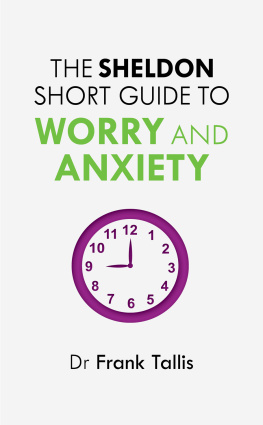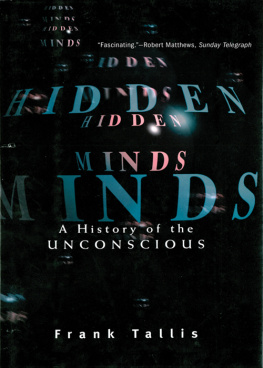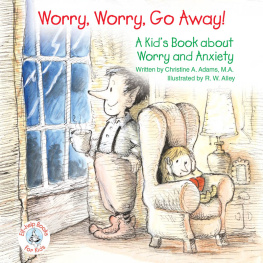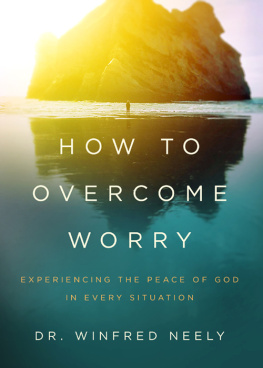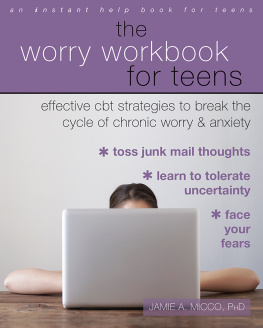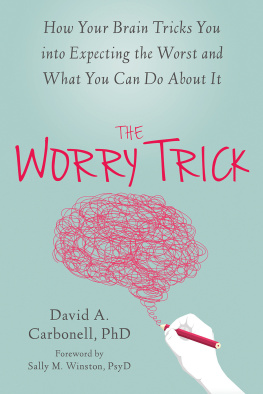
The Sheldon Short Guide to
Worry and Anxiety
Dr Frank Tallis is an award-winning writer and a clinical psychologist. He has held lecturing posts in clinical psychology and neuroscience at the Institute of Psychiatry, Psychology and Neuroscience (Kings College, London), and is one of the countrys leading authorities on obsessional states. He is the author of Understanding Obsessions and Compulsions (Sheldon Press, 1992) and How to Stop Worrying (Sheldon Press, reissued 2014), both of which are recommended on the Reading Well Books on Prescription scheme. He has written academic textbooks and over thirty academic papers, and is the author of several acclaimed novels.
Sheldon Short Guides
Depression
Dr Tim Cantopher
Memory Problems
Dr Sallie Baxendale
Phobias and Panic
Professor Kevin Gournay
Worry and Anxiety
Dr Frank Tallis
THE SHELDON
SHORT GUIDE TO
WORRY AND
ANXIETY
Dr Frank Tallis

First published in Great Britain in 2015 by Sheldon Press
An Hachette UK Company
Sheldon Press
Carmelite House
50 Victoria Embankment
London EC4Y 0DZ
www.sheldonpress.co.uk
Copyright Dr Frank Tallis 2015
All rights reserved. No part of this book may be reproduced or transmitted in any form or by any means, electronic or mechanical, including photocopying, recording, or by any information storage and retrieval system, without permission in writing from the publisher.
British Library Cataloguing-in-Publication Data
A catalogue record for this book is available from the British Library
ISBN 9781847093653
What is worry? In spite of the fact that most people experience worry, professional mind-watchers like psychologists and psychiatrists have had very little to say about it. However, although professionals have failed to provide us with an agreed definition of worry, we can describe it and establish some common features of worry.
Two important features of worry are:
lack of control over repetitive bad thoughts;
a tendency to think things are going to get worse.
Jenny
Jenny couldnt concentrate. Her attention was constantly being interrupted by thoughts. Not just any thoughts, but bad, uncontrollable ones. The bad thoughts tended to get worse and worse, a process sometimes called catastrophizing.
This book is about how you might learn to control your worries. We will not attempt to treat or cure worry, because this would be extremely unwise. As you are about to find out, in some situations worry might have very real advantages.
Does worry have a purpose?
Thoughts and feelings dont just happen. They occur for a reason.
Lets take a closer look at fear to illustrate this point. When you get frightened, certain things happen to your body. Chemicals, like adrenaline, are released into the blood, causing many changes: an increase in heart rate, heavy breathing, sweating and the movement of blood away from some areas of the body for example, the skin to the muscles. These changes occur simply to prepare the body for action, and to equip us best for fight or flight. An increased heart rate, and the movement of blood away from areas like the skin, will supply the muscles with all the chemicals required for vigorous activity to fight harder or run faster, depending on which response is chosen.
Fear, then, alters your body so that the chances of surviving a dangerous situation are improved. The idea that feelings have useful functions is not a new one. In fact Charles Darwin, the famous originator of the theory of evolution, was the first person to suggest that certain characteristics appear in both humans and animals because they have helped the species to survive. Clearly, fear is an extremely helpful emotion, albeit unpleasant.
Worry, then, is a response to a problem. Perhaps worry acts like an internal alarm system.
Another helpful effect of worry might be preparation. If thoughts and images relating to an unpleasant situation keep on coming into your mind, then this might help you to deal with the situation when it actually happens.
From the above we can see that worrying, although unpleasant, is in fact a perfectly normal thing to do. Worry might act as an alarm, telling you that a problem needs to be dealt with, while at the same time preparing you to deal with that problem. Worry is only a bad thing when it either starts unnecessarily or carries on for too long. Why, then, do some people worry more than others?
Why do I worry so much?
Everybody is different. We all have different beliefs and expectations. Because of these differences, no two people will react identically given the same situation.
Clearly, people who worry a lot tend to take a negative view of things and expect the worst. Why some people have this attribute and others dont is an extremely difficult question to answer. Perhaps it is a habit acquired during childhood. How we think and behave is strongly influenced by the way our parents think and behave. Parents provide children with example behaviours that tend to be copied. If we grow up in a family where it is normal to expect the worst, then it is quite likely that we will grow up expecting the worst too.
Although this sounds very plausible, note that at this stage we can only speculate on the influence of parenting on personality development and worry. Parental influence is probably just one of many factors that can shape our attitudes and beliefs. Others might include, for example, distressing life experiences. If you have had a lot of bad luck, and things keep on going wrong for you, then it will be difficult for you to maintain a positive picture of the world.
You can change this, using effective problem-solving techniques, which well look at next. Before we do so, lets remind ourselves how worry is triggered.
A situation is thought to be threatening because it contains the possibility of one or more bad outcomes.
Thoughts and images remind the individual that there is a problem that needs to be dealt with.
If the individual fails to deal with the problem, worry will continue.
But if the problem is dealt with, worry will stop. At worst, a few unpleasant thoughts might continue to be a nuisance before disappearing altogether.
Dealing with problems effectively
Situations that make us worry are problem situations. In a way, they should be treated like crossword puzzles or anagrams. If youre doing a puzzle of any kind, you have to think about it first. This process is known as problem-solving .
Everyday problem-solving can be broken down into a number of stages:
Define the problem. Be very specific: for example, I cant pay my heating bill.
Think up as many ways of dealing with the problem as possible: for example, I could get a loan or I could do some extra overtime at work.
Decide which of these strategies is the best one.
Do it!
Worriers appear to be very good at defining problems but extremely bad at solving them. There are a number of reasons why this might be. However, research has shown that worriers tend to be slower than non-worriers when attempting to make a decision. This delay seems to stem from worriers reluctance to make decisions unless they are absolutely sure that they are doing the right thing.
The longer it takes you to deal with a problem, the longer you will worry about it. Sometimes just deciding on a course of action will help you to stop worrying. If you make a decision to act in one way rather than another then you have reduced the uncertainty of your future.
Next page
